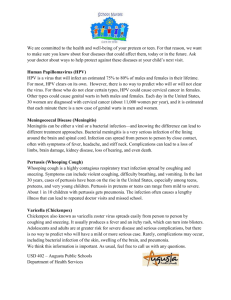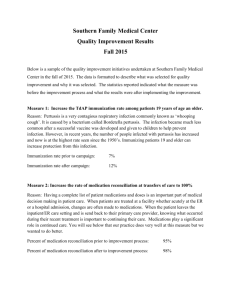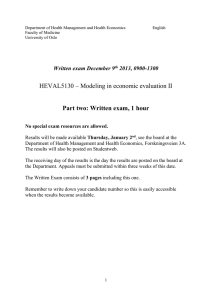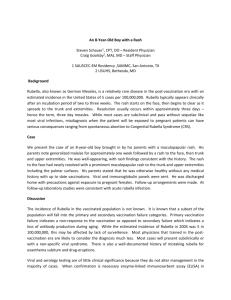T ARTS + CULTURE
advertisement
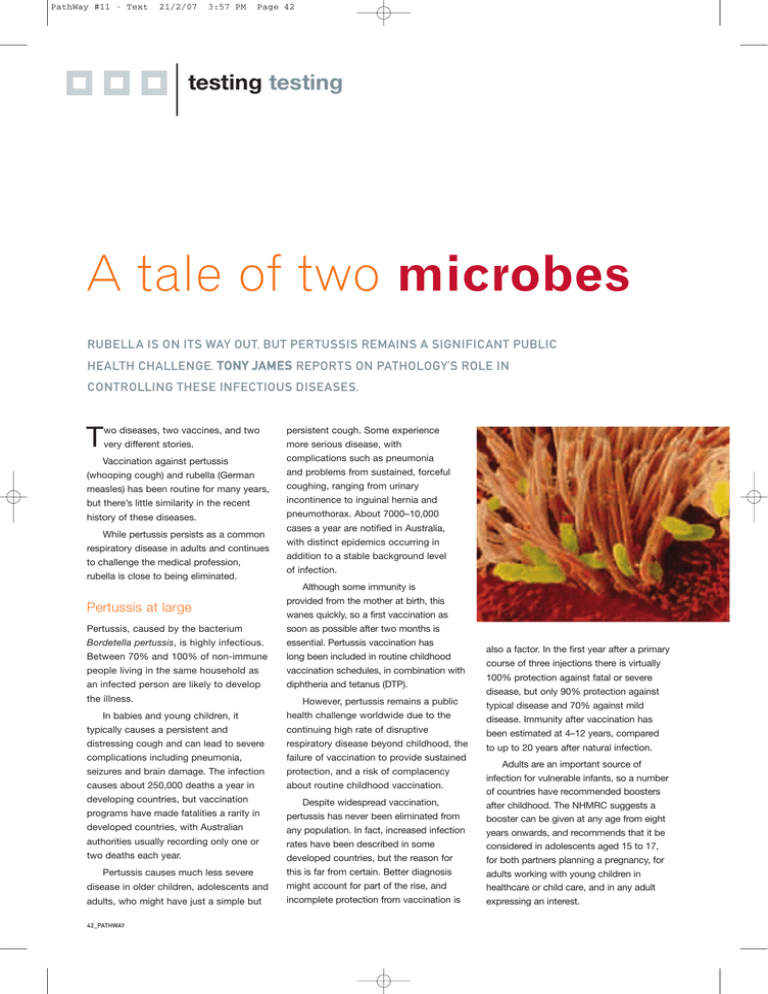
PathWay #11 - Text 21/2/07 ARTS + CULTURE 3:57 PM Page 42 testing testing A tale of two microbes RUBELLA IS ON ITS WAY OUT, BUT PERTUSSIS REMAINS A SIGNIFICANT PUBLIC HEALTH CHALLENGE. TONY JAMES REPORTS ON PATHOLOGY’S ROLE IN CONTROLLING THESE INFECTIOUS DISEASES. wo diseases, two vaccines, and two persistent cough. Some experience very different stories. more serious disease, with Vaccination against pertussis complications such as pneumonia T (whooping cough) and rubella (German and problems from sustained, forceful measles) has been routine for many years, coughing, ranging from urinary but there’s little similarity in the recent incontinence to inguinal hernia and history of these diseases. pneumothorax. About 7000–10,000 While pertussis persists as a common respiratory disease in adults and continues to challenge the medical profession, rubella is close to being eliminated. cases a year are notified in Australia, with distinct epidemics occurring in addition to a stable background level of infection. Although some immunity is Pertussis at large provided from the mother at birth, this wanes quickly, so a first vaccination as Pertussis, caused by the bacterium soon as possible after two months is Bordetella pertussis, is highly infectious. essential. Pertussis vaccination has Between 70% and 100% of non-immune long been included in routine childhood people living in the same household as vaccination schedules, in combination with an infected person are likely to develop diphtheria and tetanus (DTP). the illness. However, pertussis remains a public also a factor. In the first year after a primary course of three injections there is virtually 100% protection against fatal or severe disease, but only 90% protection against typical disease and 70% against mild health challenge worldwide due to the disease. Immunity after vaccination has typically causes a persistent and continuing high rate of disruptive been estimated at 4–12 years, compared distressing cough and can lead to severe respiratory disease beyond childhood, the to up to 20 years after natural infection. complications including pneumonia, failure of vaccination to provide sustained seizures and brain damage. The infection protection, and a risk of complacency causes about 250,000 deaths a year in about routine childhood vaccination. In babies and young children, it developing countries, but vaccination Despite widespread vaccination, Adults are an important source of infection for vulnerable infants, so a number of countries have recommended boosters after childhood. The NHMRC suggests a programs have made fatalities a rarity in pertussis has never been eliminated from developed countries, with Australian booster can be given at any age from eight any population. In fact, increased infection years onwards, and recommends that it be authorities usually recording only one or rates have been described in some considered in adolescents aged 15 to 17, two deaths each year. developed countries, but the reason for for both partners planning a pregnancy, for Pertussis causes much less severe this is far from certain. Better diagnosis adults working with young children in disease in older children, adolescents and might account for part of the rise, and healthcare or child care, and in any adult adults, who might have just a simple but incomplete protection from vaccination is expressing an interest. 42_PATHWAY PathWay #11 - Text 21/2/07 3:57 PM Page 43 Pertussis remains a public health challenge due to the continuing high rate of disruptive respiratory disease beyond childhood... and a risk of complacency about routine PHOTO CREDIT: PAUL WRIGHT childhood vaccination. Above: Dr David Mitchell: “Much of the data on the epidemiology of pertussis is unreliable.” Left: Scanning electron micrograph of Bordatella pertussis infection (green). Pertussis in the path lab Pathology tests for pertussis are designed to diagnose current infection or to confirm a recent infection. Dr David Mitchell, an in very small samples, are now the other macrolide antibiotics can reduce the during the first few weeks of infection. severity of symptoms and can help Aspirating fluid from the nasopharynx infectious diseases physician and is the optimal method of obtaining microbiologist at Sydney’s Westmead specimens, but the procedure is Hospital, says the organism is fastidious uncomfortable and disliked by adults, in and very difficult to culture in the laboratory. whom throat swabs are usually adequate. “Growing the organism is the ideal “PCR has limitations too,” Dr Mitchell way to make a diagnosis, and it also says. “For example, it detects dead allows us to study the bacterium, its organisms as well as living ones, so it sensitivity to antibiotics and the way that it can’t be used to monitor the success of might be changing over time, but in most treatment.” cases this is not an option,” he says. “Only a few specialised paediatric laboratories have the facilities for culture.” Polymerase chain reaction (PCR) tests for fragments of bacterial DNA, detectable Early treatment with erythromycin or method of choice for identifying pertussis Diagnosing a current infection has the greatest benefit where the patient might prevent infection of close contacts. But decisions about excluding a staff member from work, monitoring others for infection, and possibly treating others to prevent infection can have serious implications and therefore require good evidence that the infection exists. Serology – testing for antibodies to pertussis – can help confirm that the infection has occurred in people who have experienced typical symptoms, but is not particularly reliable. “The tests available for routine pose a threat to others, for example a laboratory use are neither sensitive nor staff member working in a neonatal specific for pertussis and can lead to intensive care unit, Dr Mitchell says. over-diagnosis,” Dr Mitchell says. > PATHWAY_43 PathWay #11 - Text 21/2/07 3:57 PM Page 44 Rubella infections have continued to decline and now number fewer than 200 a year, compared to about 3000 annually in the early 1990s. “This can be a problem when we are Only 10–20% of babies are affected factors such as vaccination history, attempting to control an outbreak or if the mother has rubella after 16 previous antenatal screening tests, and restrict the spread of the disease in a weeks’ gestation. the date and duration of possible contact workplace. It also means that much of Girls were first vaccinated against with other infected people. A sharp rise in the data on the epidemiology of pertussis rubella in the 1960s, and immunisation – IgG antibodies can also be detected is unreliable.” like natural infection – provides long-term within four to five days of symptom onset, protection. Rubella is now combined with but patients are rarely tested at this early measles and mumps vaccinations (MMR) stage. IgM levels remain elevated for 8–12 in routine immunisations. weeks after infection. Careful interpretation Like all pathology tests, the results of pertussis serology have to be interpreted carefully in light of the patient’s illness. In a general practice environment, evidence that a patient has developed antibodies to pertussis after an episode of typical illness can provide some reassurance about the cause and likely course of the illness, and help rule out other causes of persistent cough. Serology tests are not needed, and A national ‘catch-up’ campaign in be used to check for foetal infection if a Australian adolescents, particularly the woman wishes to continue with a cohort of boys who had missed childhood pregnancy after contracting rubella. Tests immunisation. As a result, rubella include IgM levels in foetal blood sampled infections have continued to decline and from the umbilical cord, or testing for viral now number fewer than 200 a year, genetic material in foetal blood or compared to about 3000 annually in the chorionic-villus samples. early 1990s. Only one or two cases of congenital rubella syndrome are reported in Australia annually. aren’t helpful, in deciding whether an adolescent or adult should be revaccinated. Greater success, however, has been achieved in controlling rubella. This virus usually causes a self-limiting disease in adults. Inhalation typically leads to multiplication in the upper respiratory tract, then fever, a skin rash and spread of the virus to organs including the placenta of pregnant women. In 1941 an Australian ophthalmologist, Norman Gregg, first made the link between rubella and birth defects. He observed that some babies were The main aim of diagnosing current or recent rubella infection is to assist a pregnant woman to make an informed sufficiently high uptake of MMR sexes. The NHMRC recommends vaccination of non-pregnant women lacking antibodies, and female immigrants who have entered Australia after the age of routine vaccination – especially those baby and whether the pregnancy should from Asia, where natural infection rates be terminated. Serological tests for and levels of immunity are low. antibodies are required in any pregnant woman who is thought to have rubella or Screening for rubella antibodies is now a standard part of antenatal care. who has been in contact with others who have the disease, regardless of their vaccination history. A number of other rash-causing viral GPs NOTE: This article is available for patients at http://pathway.rcpa.edu.au illnesses – including measles, parvovirus B19, human herpesvirus 6 and enterovirus – can closely resemble rubella and cannot mothers had rubella during pregnancy. be distinguished clinically, so laboratory very likely to lead to foetal damage, with some years until there has been a decision about the risk to her developing with congenital heart disease – after their in the first 8–10 weeks of pregnancy is The risk of rubella will continue for vaccination by children and adults of both Role of rubella lab tests born with congenital cataract – some also It’s now known that maternal infection Specialised pathology tests can also 1998 aimed to ensure vaccination of all Further reading Crowcroft NS, Pebody RG. Recent confirmation is essential to make the developments in pertussis. Lancet diagnosis. 2006;367:1926–36. The presence of rubella-specific IgM Banatvala JE, Brown DW. Rubella. Lancet long-term consequences such as strongly indicates current or recent 2004;363:1127–37. blindness, deafness, mental handicap and infection, but the result must be NHMRC, The Australian Immunisation cardiac abnormalities. interpreted by a specialist in light of Handbook, 8th edition, 2003. 44_PATHWAY
